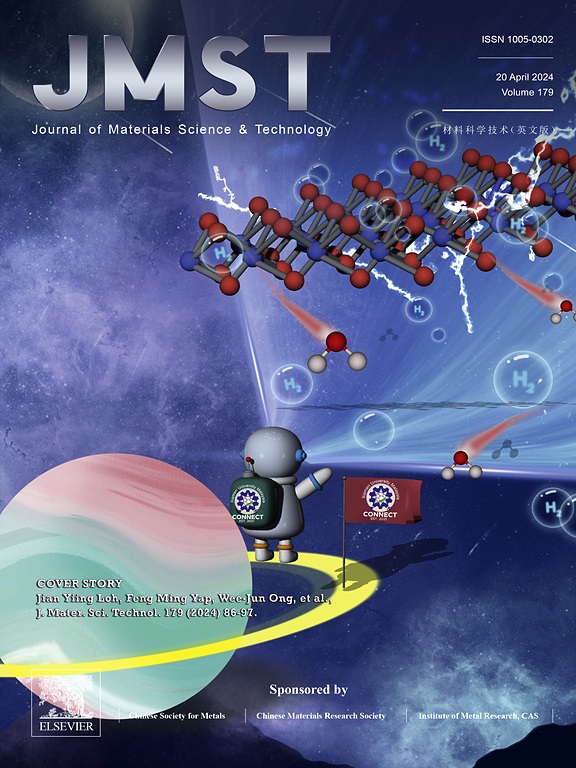RPV钢早期时效过程中含c富锰硅析出相的溶质原子迁移与演化
IF 14.3
1区 材料科学
Q1 MATERIALS SCIENCE, MULTIDISCIPLINARY
引用次数: 0
摘要
众所周知,在核电站的长期使用中,反应堆压力容器(RPV)钢中Mn-Ni-Si析出物的形成会导致硬化和脆化。然而,由于表征技术的限制,溶质原子在服务初期的迁移和局部聚集行为仍然难以捉摸。本文采用内摩擦(IF)、透射电子显微镜(TEM)和小角散射(SAS)技术,系统研究了RPV钢早期时效过程中沿晶界析出的含c mn - si富相(C-MSPs)的溶质原子迁移和聚集行为以及热力学特征。中频结果显示出P1、P2和P3三个主峰,其中P1和P2对应于受Mn、Ni和Si原子影响的C-Snoek峰,而P3代表由在GB析出的C-MSPs含量调制的GB弛豫。在短期时效(≤5 h)过程中,P1的高度持续下降,而P2的高度先升高后降低,表明C原子最初与取代原子(Me=Mn、Ni和Si)相互作用形成C-Me对,随后在GBs处共析出C- msp,溶质原子聚集和析出同时发生,时间延长(≤100 h)。随着老化时间和温度的增加,P3的高度逐渐降低,反映了GBs处C-MSPs含量逐渐增加,与TEM和SAS观察结果一致。C-MSPs的溶质聚集和沉淀活化能分别为0.87和1.30 eV,表明C-MSPs的生长主要受GB扩散的控制。此外,还提供了溶质原子迁移、C-MSPs成核和生长的示意图,以及C-MSPs演化的时间-温度转变(TTT)图。本工作描绘了服役初期RPV钢微观组织演变的景观图,为指导RPV钢的成分设计提供了有价值的见解。本文章由计算机程序翻译,如有差异,请以英文原文为准。

Solute atom migration and evolution of C-bearing Mn-Si-rich precipitates in RPV steel during the early aging period
It is well-known that the formation of Mn-Ni-Si precipitates in reactor pressure vessel (RPV) steels during extended service in nuclear power plants results in hardening and embrittlement. However, the migration and local aggregation behavior of solute atoms in the early service period remains elusive due to limitations in characterization techniques. In this work, the migration and aggregation behavior of solute atoms, along with the thermodynamic characteristics of C-bearing Mn-Si-rich phases (C-MSPs) precipitated along grain boundaries (GBs) during the early aging period of RPV steels were systematically investigated using internal friction (IF), transmission electron microscopy (TEM), and small-angle scattering (SAS) techniques. The IF results reveal three primary peaks, designated as P1, P2, and P3, where the P1 and P2 correspond to C-Snoek peaks influenced by Mn, Ni, and Si atoms, while the P3 represents GB relaxation modulated by the content of C-MSPs precipitated at GBs. During short-term aging (≤ 5 h), the height of the P1 decreases consistently, whereas the P2 initially increases and then decreases, indicating that C atoms initially interact with substituent atoms (Me=Mn, Ni, and Si) to form C-Me pairs and subsequently co-precipitate as C-MSPs at GBs, with solute atoms aggregation and precipitation occurring concurrently over an extended period (≤ 100 h). The height of the P3 decreases with increasing aging time and temperature, reflecting a gradual increase in C-MSPs content at GBs, consistent with TEM and SAS observations. Activation energies of 0.87 and 1.30 eV for solute aggregation and precipitation of C-MSPs, respectively, suggest that the growth of C-MSPs is predominantly governed by GB diffusion. Furthermore, a schematic diagram illustrating solute atom migration, C-MSPs nucleation, and growth, along with a time–temperature–transformation (TTT) diagram for C-MSPs evolution is provided. This work portrays the landscape map of the microstructural evolution of RPV steels during the early service period, offering valuable insights for guiding the compositional design of RPV steels.
求助全文
通过发布文献求助,成功后即可免费获取论文全文。
去求助
来源期刊

Journal of Materials Science & Technology
工程技术-材料科学:综合
CiteScore
20.00
自引率
11.00%
发文量
995
审稿时长
13 days
期刊介绍:
Journal of Materials Science & Technology strives to promote global collaboration in the field of materials science and technology. It primarily publishes original research papers, invited review articles, letters, research notes, and summaries of scientific achievements. The journal covers a wide range of materials science and technology topics, including metallic materials, inorganic nonmetallic materials, and composite materials.
 求助内容:
求助内容: 应助结果提醒方式:
应助结果提醒方式:


